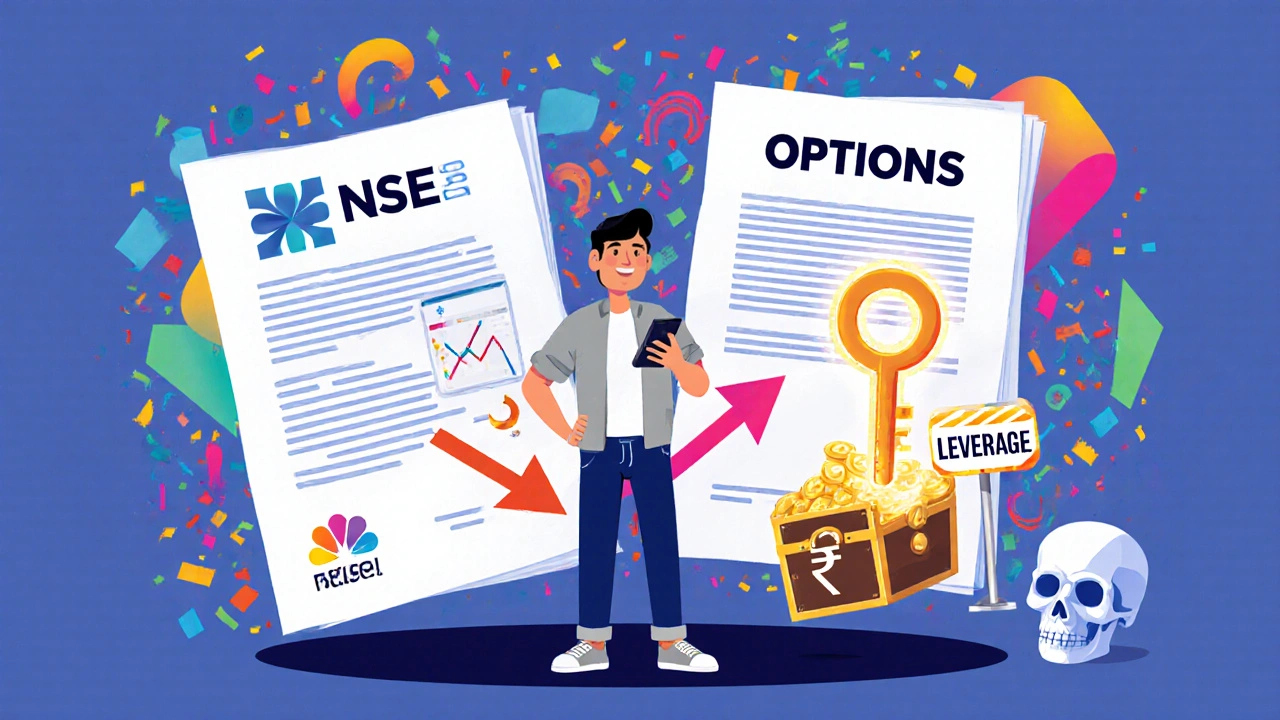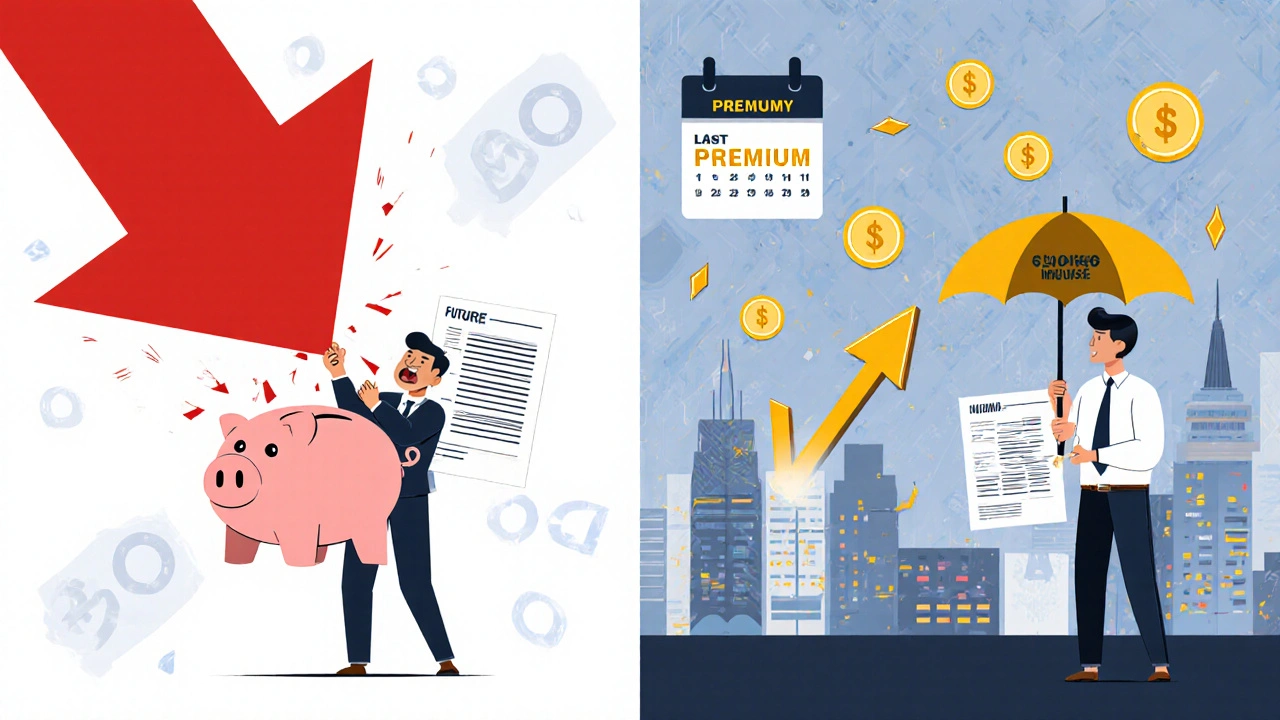Understanding F&O in India: Futures and Options Basics for Equity Traders
 Nov, 16 2025
Nov, 16 2025
If you’ve ever seen a stock price jump 10% in a day and wondered how some traders make big profits without owning the stock, you’ve seen F&O in action. Futures and Options - often called F&O - are tools used by millions of Indian equity traders to bet on price movements, hedge risks, or amplify gains. But for newcomers, the jargon can feel like a foreign language. This isn’t about complex math or Wall Street secrets. It’s about understanding how these tools actually work on the NSE and BSE, and how you can use them without blowing up your account.
What Exactly Are Futures and Options?
Futures and Options are both derivatives. That means their value comes from something else - usually a stock or index like Nifty 50 or Bank Nifty. You don’t buy the stock itself. You buy a contract that gives you the right or obligation to buy or sell it later at a set price.
Futures are agreements. You promise to buy or sell a stock at a specific price on a specific date. No choices. If you agree to buy Tata Motors at ₹500 next month, you must buy it at ₹500, even if it’s trading at ₹450 or ₹580 when the contract ends.
Options are rights. You pay a small fee (called a premium) for the right - but not the obligation - to buy (call option) or sell (put option) a stock at a set price before or on a certain date. If the market moves against you, you walk away. You only lose the premium.
Think of it like this: Futures are like pre-ordering a phone at ₹50,000. You’re locked in. Options are like paying ₹2,000 for the right to buy that same phone at ₹50,000 next month. If the phone drops to ₹40,000, you don’t buy it. You lose only ₹2,000. If it jumps to ₹60,000, you buy it at ₹50,000 and pocket the difference.
Why Do Traders Use F&O in India?
Most retail traders don’t use F&O to own stocks. They use it to profit from price swings - fast. Here’s why it’s so popular:
- Leverage: You can control ₹5 lakh worth of stock with just ₹50,000. That’s 10x leverage. A 5% move in the stock can mean a 50% gain - or loss - on your capital.
- Short selling made easy: You can sell a stock you don’t own. If you think Reliance will fall, you can sell a futures contract or buy a put option. No need to borrow shares like in traditional markets.
- Hedging: If you own 100 shares of Infosys and fear a market dip, you can buy a Nifty put option. If the market crashes, your option gains offset your stock loss.
- Liquidity: Nifty and Bank Nifty options are the most traded in India. You can enter and exit positions in seconds, even with large amounts.
According to NSE data from 2024, over 70% of daily F&O volume comes from retail traders. That’s not because they’re all experts - it’s because the barrier to entry is low. You can start with as little as ₹5,000.
Key Terms You Must Know
Before you trade, learn these five terms. They’re the foundation:
- Underlying asset: The stock or index the contract is based on - like HDFC Bank or Nifty 50.
- Strike price: The price at which you can buy (call) or sell (put) the asset. For a Nifty 24,500 call, you can buy Nifty at 24,500 if you exercise the option.
- Expiry date: Every F&O contract has a fixed end date. In India, it’s the last Thursday of every month. If that’s a holiday, it moves to the previous Wednesday.
- Premium: The price you pay to buy an option. It’s non-refundable. Even if the option expires worthless, you lose the premium.
- Margin: The deposit you must put up to trade futures. It’s usually 15-25% of the contract value. Brokers like Zerodha or Upstox calculate this automatically.
Don’t skip this step. Mistaking strike price for market price is how beginners lose money fast.
Futures vs Options: The Real Difference
Here’s a simple breakdown:
| Feature | Futures | Options |
|---|---|---|
| Obigation | You MUST buy/sell | You CAN buy/sell - not required |
| Upfront cost | Margin (deposit) | Premium (non-refundable fee) |
| Loss potential | Unlimited - if market moves against you | Limited to premium paid |
| Profit potential | Unlimited - if market moves your way | Unlimited for calls, capped for puts |
| Best for | Traders confident in direction | Traders wanting limited risk |
Most beginners start with options because the risk is capped. If you buy a ₹500 call option and the stock crashes, you lose ₹500 - not ₹50,000. With futures, a 2% drop against you can wipe out your entire margin.

How to Start Trading F&O in India
You can’t trade F&O with a regular demat account. You need a derivative trading segment enabled. Here’s how:
- Open a trading account with a SEBI-registered broker like Zerodha, Upstox, or Groww.
- Apply for F&O trading permission. You’ll need to sign a risk disclosure form and pass a basic quiz on derivatives.
- Link your bank account and complete KYC if not done already.
- Deposit margin for futures or premium for options.
- Start small. Trade one lot of Bank Nifty or a single stock like ICICI Bank. Don’t go all-in.
Most brokers let you trade in lots. A lot is the minimum number of shares you can trade. For example, one lot of TCS might be 25 shares. If TCS is ₹3,000, one lot is ₹75,000. But you don’t pay the full amount - just the margin, say ₹15,000.
Common Mistakes New Traders Make
Here’s what goes wrong - and how to avoid it:
- Buying deep out-of-the-money options: A ₹100 strike option on a ₹500 stock might cost ₹5. It looks cheap. But the chance it becomes profitable is near zero. Stick to at-the-money or slightly out-of-the-money options.
- Ignoring time decay: Options lose value every day as expiry nears. Holding them too long without a strong price move is like watching money burn.
- Trading without a plan: Don’t enter a trade because “it feels right.” Know your entry, exit, and stop-loss before clicking buy.
- Over-leveraging: Using 20x leverage on a single trade is gambling, not trading. Stick to 5x or less until you’re consistently profitable.
- Trading illiquid contracts: Avoid options on small-cap stocks with low volume. You won’t be able to exit when you want to.
A 2023 SEBI survey found that 78% of retail F&O traders lost money in their first year. Most didn’t lose because the market was against them. They lost because they didn’t understand the tools they were using.
Real Example: How a Simple Option Trade Works
Let’s say you believe HDFC Bank will rise over the next two weeks. It’s trading at ₹1,650.
- You buy one lot of HDFC Bank 1,700 Call option (strike price ₹1,700).
- It costs ₹45 per share. One lot = 250 shares. Total premium = ₹45 × 250 = ₹11,250.
- Two weeks later, HDFC Bank is at ₹1,780.
- Your option is now worth ₹80 per share (1,780 - 1,700). Total value = ₹80 × 250 = ₹20,000.
- Your profit = ₹20,000 - ₹11,250 = ₹8,750.
You turned ₹11,250 into ₹20,000 - a 78% gain in two weeks. But if HDFC Bank stayed below ₹1,700, you’d lose only ₹11,250. That’s the power of options.

What Happens at Expiry?
Options and futures don’t just vanish. They settle:
- In-the-money options: Automatically exercised. You get cash equal to the difference between market price and strike price.
- Out-of-the-money options: Expire worthless. You lose the premium.
- Futures: Settled in cash. No physical delivery. You pay or receive the difference between your contract price and the closing price on expiry day.
You don’t need to own the stock. You don’t need to take delivery. Everything is cash-settled in India. That’s why F&O is so popular - it’s pure speculation, no paperwork.
When Should You Avoid F&O?
F&O isn’t for everyone. Walk away if:
- You don’t understand how leverage works.
- You’re using money you can’t afford to lose - rent, emergency fund, education fees.
- You’re trying to recover past losses. F&O is not a casino for revenge trading.
- You trade without a strategy. No stop-loss, no target, no plan.
Even experienced traders lose big when they ignore discipline. F&O magnifies both wins and losses. Treat it like a tool - not a lottery ticket.
Where to Learn More
Start with NSE’s free online modules on derivatives. They’re clear, simple, and updated for 2025. Read the Derivatives Market (Basic) Module - it’s only 3 hours long. Then practice with a paper trading account. Zerodha’s Kite has a demo mode. Trade with fake money for a month. See how you react when your position goes against you.
Don’t jump into live trading until you’ve made 10 winning paper trades in a row - not because you’re lucky, but because you followed your plan every time.
Can I trade F&O without a demat account?
No. You need a demat account to hold shares, but for F&O trading, you only need a trading account with derivatives enabled. Since all F&O trades in India are cash-settled, you don’t need to take physical delivery. But your broker will still require a demat account for KYC and linkage purposes.
What’s the minimum capital to start F&O trading?
You can start with as little as ₹5,000 if you trade small lots of liquid options like Nifty or Bank Nifty. But ₹15,000-₹25,000 gives you more flexibility and reduces the risk of margin calls. Never risk more than 5% of your total capital on a single trade.
Are F&O profits taxed differently in India?
Yes. F&O trading is classified as non-speculative business income. Profits are taxed at your slab rate. Losses can be carried forward for up to 8 years and offset against future F&O profits. STT (Securities Transaction Tax) is already included in your trade cost - no extra tax at exit.
Can I hold F&O positions overnight?
Yes, but only if you have enough margin. Intraday F&O trades are settled the same day. If you hold overnight, it becomes a positional trade. Your broker will block margin daily. If the market moves against you and your margin falls below the required level, you’ll get a margin call - and if you don’t add funds, your position will be squared off automatically.
Is F&O trading gambling?
It’s gambling only if you trade without a plan, ignore risk management, or chase losses. When used with discipline, strategy, and education, F&O is a legitimate financial tool. Professional traders use it to hedge portfolios and exploit volatility. The difference is control - not luck.
Final Thought: F&O Is a Tool, Not a Shortcut
Futures and Options aren’t magic. They don’t turn ₹10,000 into ₹10 lakh overnight. They’re high-speed tools that reward preparation and punish recklessness. The same contract that can make you a 10x return can also wipe you out in minutes. The best traders don’t win because they’re smart - they win because they’re patient, consistent, and respectful of risk.
If you’re serious about learning F&O, start slow. Read. Practice. Observe. Trade small. Protect your capital. The market will give you plenty of chances to make money. Your job is to be ready when they come - not to force them.
